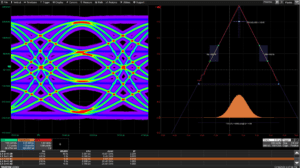Teledyne LeCroy has released a beta version of software for automating serial-data analysis on PAM4 signals. Engineers can request a copy.
By using PAM4 modulation, PCIe 6.0 doubles data rates to 64 GT/sec (256 Gb/sec when using an x16 configuration). The “secret sauce” in the doubling comes from PAM4, which puts four voltage levels in the space where two used to go.
 Teledyne LeCroy has released a beta version QPHY-PCIE6-TX-RX software for key customers. The software automates serial-data analysis for the LabMaster 10 Zi-A oscilloscope (50 GHz or higher) and SDAIII-CompleteLinQ serial data analysis software.
Teledyne LeCroy has released a beta version QPHY-PCIE6-TX-RX software for key customers. The software automates serial-data analysis for the LabMaster 10 Zi-A oscilloscope (50 GHz or higher) and SDAIII-CompleteLinQ serial data analysis software.
The table highlights measurements you can make with the software and oscilloscope.
“Teledyne LeCroy’s SDAIII-PCIe6 and SDAIII-PAMx software options are currently available,” product manager Anthony Mickens told EE World. “The QPHY-PCIe6-Tx-Rx software package functions much like all previous generations of the QPHY compliance packages we have created for PCI Express (versions 1.1, 2.0, 3.0, 4.0, and 5.0). We opened the window for more engineers to participate in beta testing for the QPHY-PCIe6-Tx-Rx package. Anyone interested can request the software through our Lighthouse Partners Program.”
“The SDAIII-PCIe6 and SDAIII-PAMx are the core engines for the jitter, eye diagram, and other new analysis that the PAM4-based PCIe 6.0 standard requires,” continued Mickens. “The QPHY-PCIe6-Tx-Rx package uses these core algorithmic engines to automate the process. Engineers can manually run tests with the SDAIII-PAMx and SDAIII-PCIe6 products, but most prefer some degree of automation. Teledyne LeCroy often launches automated (compliance) packages first in beta because new standards tend to undergo numerous iterations as they near completion.”
The table highlights measurements you can make with the software running on the LabMaster 10 Zi-A.
| Parameter | Description |
| TTX-RJ | Uncorrelated Random Jitter |
| TTX-UTJ | Uncorrelated Total Jitter |
| TTX-UDJDD | Uncorrelated Deterministic Jitter (Dual Dirac Model) |
| TTX-UPW-TJ | Total Uncorrelated Pulse Width Jitter |
| TTX-CH-UPW-RJ | Uncorrelated Pulse Width Random Jitter |
| TTX-CH-UPW-DJ | Uncorrelated Pulse Width Deterministic Jitter |
| TTX-UPW-DJDD | Uncorrelated Pulse Width Jitter Deterministic (Dual Dirac Model) |
| SNDR | Signal-to-Noise-Distortion Ratio |
| RLM | Level Separation Mismatch Ratio |
| SNR | Signal-to-Noise Ratio |
| SDR | Signal-to-Distortion Ratio |
| Pmax | Maximum Pulse Amplitude |
| Sigma E | Average Deviation from Pulse Response |
| Sigma N | Noise |
| VTX-DIFF-PP | Differential Peak-Peak Voltage |
| TX-PS21 | Package Loss |
| VTX-EIEOS-FS | Electrical Idle Exit Order Set Voltage |
| VTX-CM-AC-PP | Common Mode AC Peak-Peak Voltage |

Leave a Reply
You must be logged in to post a comment.